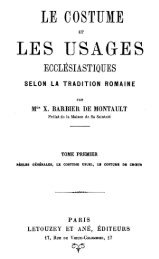The Etymologies of Isidore of Seville - Pot-pourri
The Etymologies of Isidore of Seville - Pot-pourri
The Etymologies of Isidore of Seville - Pot-pourri
You also want an ePaper? Increase the reach of your titles
YUMPU automatically turns print PDFs into web optimized ePapers that Google loves.
so called because water is strained (percolare) through<br />
them. People say that Tarquinius Priscus first made these<br />
in Rome in order that, whenever there was a downpour<br />
<strong>of</strong> rain, water would pass through them out <strong>of</strong> the city<br />
so that the destructive force <strong>of</strong> water in very great and<br />
prolonged storms would not destroy the level places or<br />
foundations <strong>of</strong> the city. 26. Porticos(imbolus) areso<br />
named either because they are ‘under the mass’ (subvolumen),<br />
8 or because people walk (ambulare) under them,<br />
for they are the arcades found here and there along the<br />
boulevards.<br />
27. Aforum(forus, i.e. the archaic form <strong>of</strong> forum)<br />
is a place for practicing litigation, named from “speaking”<br />
(fari) [orfromKingPhoroneus,wh<strong>of</strong>irstgavelaw<br />
to the Greeks]. <strong>The</strong>se places are also called prorostra (lit.<br />
“before the prows”) because prows (rostrum)wereseized<br />
from captured Carthaginian ships in the Punic War and<br />
set up in the Roman Forum as a sign <strong>of</strong> this victory.<br />
28. <strong>The</strong> Senate House (curia) issocalled because there<br />
the oversight (cura) <strong>of</strong>allaffairs is administered by the<br />
Senate. 29. Apraetorium is so named because there a<br />
‘judicial magistrate’ (praetor) has his seat for managing<br />
investigations. 30. Agymnasium (gymnasium) ingeneral<br />
is a place for exercising, but in Athens it was a place<br />
where philosophy was discussed and the study <strong>of</strong> wisdom<br />
was engaged in, for the Greeks call what<br />
is called ‘exercise’ in Latin, that is, ‘meditation’ (meditatio).<br />
9 Butgymnasiums are also bathhouses and places for<br />
runners and athletes, because there people are trained in<br />
the study <strong>of</strong> their particular skills. 31.<strong>The</strong>Capitolium <strong>of</strong><br />
Rome is so called because it was the highest head (caput)<br />
<strong>of</strong> the Roman city and its religion. Others say that when<br />
Tarquinius Priscus was uncovering the foundations <strong>of</strong><br />
the Capitolium in Rome, he found on the site <strong>of</strong> the<br />
foundation the head (caput) <strong>of</strong>ahuman marked with<br />
Etruscan writing, and hence he named it the Capitolium.<br />
32.Citadels(arx)arethehigh, fortified parts <strong>of</strong> a city,<br />
for whatever are the safest places in a city are called<br />
citadels from their holding <strong>of</strong>f (arcere) theenemy. Also<br />
from this term are ‘bow’ (arcus) and‘strongbox’(arca).<br />
33. <strong>The</strong>Romanssuppose that the Circus (Circus) was<br />
8 We guess that by subvolumen <strong>Isidore</strong> means “under, i.e. supporting,<br />
the mass” <strong>of</strong> the portico ro<strong>of</strong>, linking the syllable -vol-with<br />
the -bol- <strong>of</strong>imbolus.<br />
9 Meditatio means both “practice, exercise” and “meditation, contemplation.”<br />
<strong>The</strong> <strong>Etymologies</strong> XV.ii.26–ii.40 307<br />
named for the circling (circuitus) <strong>of</strong>horses, because<br />
there horses run around (circum) the turning-posts. 34.<br />
A theater (theatrum) isnamedfrom‘spectacle’ (spectaculum),<br />
from the term (“spectacle”), because<br />
people standing in it and watching (spectare)fromabove<br />
gaze at stage-plays. 35.And an amphitheater (amphitheatrum)issocalledbecauseitiscomposed<br />
<strong>of</strong> two theaters<br />
(cf. ,“onbothsides”), for an amphitheater is round,<br />
but a theater consists <strong>of</strong> half an amphitheater, having the<br />
shape <strong>of</strong> a semicircle.<br />
36.Alabyrinth (labyrinthus)isastructurewithintricate<br />
walls, <strong>of</strong> the kind made at Crete by Daedalus where<br />
the Minotaur was shut in. If anyone should enter into<br />
it without a ball <strong>of</strong> twine he would not be able to<br />
find the way out. This building is so situated that, for<br />
those who open its doors, a terrifying thunder is heard<br />
within. It slopes down more than a hundred steps. Inside<br />
are images and monstrous effigies, innumerable passages<br />
heading every which way in the darkness, and<br />
other things done to confuse the way <strong>of</strong> those who have<br />
entered, so that it seems impossible to pass from its darkness<br />
to the light. <strong>The</strong>re are four labyrinths: first the Egyptian,<br />
second the Cretan, the third in Lemnos, the fourth<br />
in Italy. All were so constructed that not even the ages<br />
can destroy them.<br />
37. Alighthouse (farum; cf. Greek ) isavery<br />
tall tower which the Greeks and Latins in common<br />
have named ‘lighthouse’ from its particular use, because<br />
thanks to its signal <strong>of</strong> flames it may be seen from far<br />
<strong>of</strong>f by sailors. Ptolemy is said to have constructed such<br />
alighthouse near Alexandria for eight hundred talents<br />
<strong>of</strong> gold. Its function was to show a light for ships sailing<br />
at night, in order to make known the channels and the<br />
entrance to the port, so that sailors would not be deceived<br />
in the darkness and run onto the rocks – for Alexandria<br />
has tricky access with deceptive shallows. <strong>The</strong>refore<br />
from this, people call the devices built for the purpose<br />
<strong>of</strong> shining a light in ports ‘lighthouses’ (pharus), for<br />
means “light”; , “vision” (actually “landmark,<br />
pillar”). Hence Lucifer (i.e. the ‘Light-bearer’) is called<br />
in Greek.<br />
38. Coclea are tall, round towers, and they are called<br />
coclea as if the word were ‘cycles’ (cyclea), because in them<br />
one climbs in a spiraling ring. One <strong>of</strong> these in Rome is 175<br />
(Roman) feet high. 39.Hot baths (thermae)aresocalled<br />
because they are warm, for the Greeks call heat .<br />
40. Baths (balneum) are assigned their name from the

















